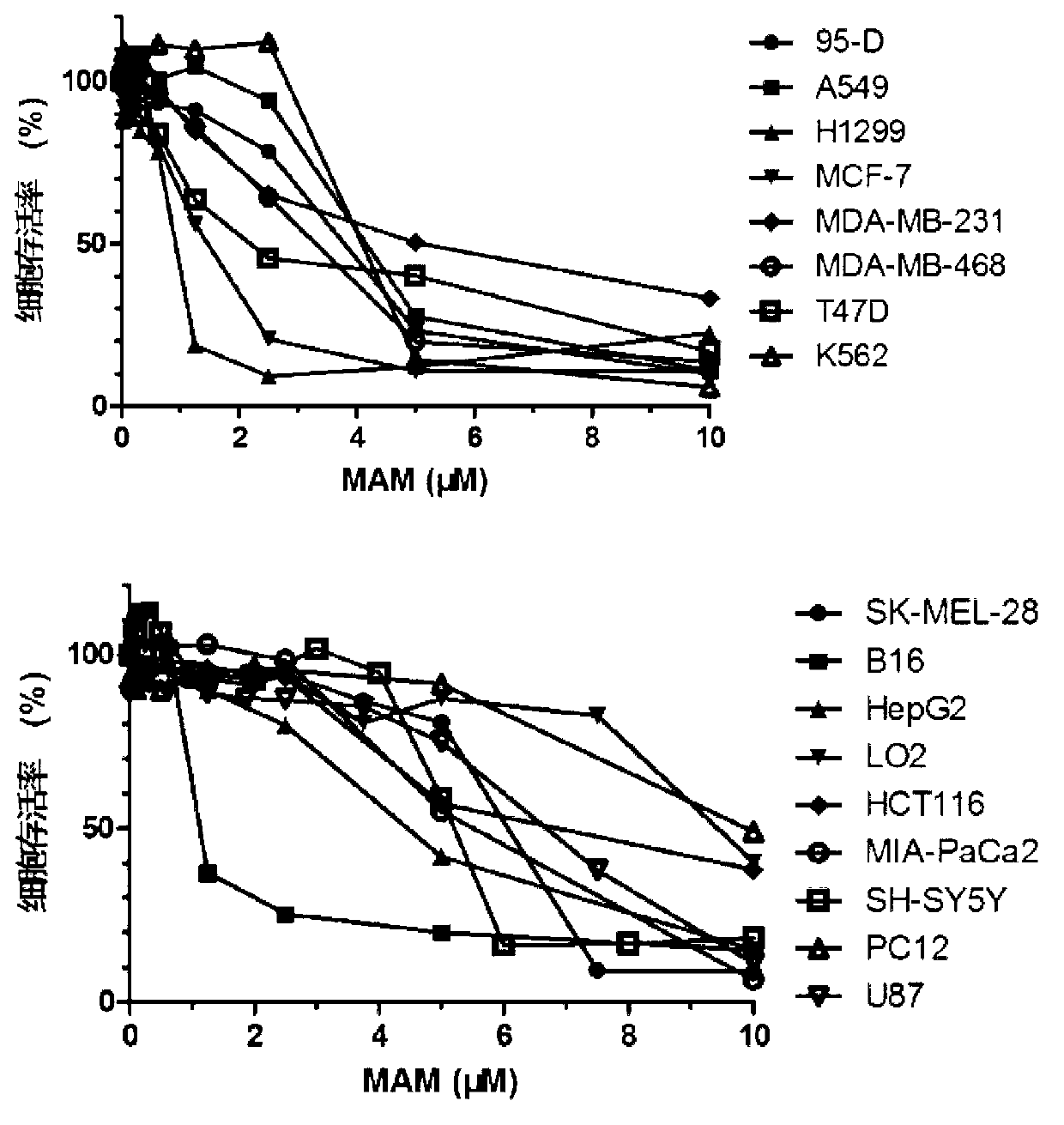Application of 2-methoxy-6-acetyl-7-methyljuglone (MAM) for preparing medicine for treating neoplastic diseases
An acetyl and methoxy technology, applied in antineoplastic drugs, drug combinations, pharmaceutical formulations, etc.
- Summary
- Abstract
- Description
- Claims
- Application Information
AI Technical Summary
Problems solved by technology
Method used
Image
Examples
Embodiment 1
[0042] Embodiment 1 (in vitro antitumor effect of MAM)
[0043] Take the tumor cells in the logarithmic growth phase and inoculate them on 96-well plates according to the size of the cells ((5-10)×10 3 per well), after 24 hours of growth, the supernatant was discarded. Then administer the drug at the following concentration, set up no drug-dosing group (blank control group) and drug-dosing group (concentration 0.1-10 μ M), each group is set up 6 duplicate wells, continue to cultivate for 24 hours, discard the supernatant, add 100 μ l containing 0.5mg / ml of MTT serum-free culture solution was incubated for 4 hours, the supernatant was discarded, 100 μl of dimethyl sulfoxide (DMSO) was added, placed on a micro-oscillator for 10 minutes, and the OD value was detected at 570 nm with a microplate reader. The normal human liver cell line LO2 was used for toxicity evaluation. Each experiment was repeated 3 times. The results are shown in Table 1 and image 3 .
[0044] image ...
Embodiment 2
[0049] Example 2 (Cell Morphological Observation)
[0050] MCF-7 cells were cultured in 96-well plates and divided into blank control group and MAM treatment group. Different concentrations of MAM (1 μM, 2 μM, 3 μM, 5 μM, 8 μM) were added to the MAM treatment group, and the same concentration of vehicle (DMSO) was added to the blank control group. After continuing to culture for 24 hours, the morphological changes of the cells were observed under a microscope.
[0051] Such as Figure 4 As shown, it was found that the cells in the blank control group had normal morphology, and after being treated with different concentrations of MAM, the cells became round, smaller, and shrunken; under the action of high concentrations of MAM, cell fragments appeared, and the cells floated, indicating death. The concentration dependence is obvious.
Embodiment 3
[0052] Example 3 (JC-1 staining to detect changes in mitochondrial membrane potential)
[0053] MCF-7 cells were cultured in 24-well plates and divided into blank control group and MAM treatment group. Different concentrations of MAM (1 μM, 2 μM, 5 μM) were added to the MAM treatment group, and the same concentration of vehicle (DMSO) was added to the blank control group. After continuing to culture for 4 hours, stain with JC-1 dye in the dark (final concentration 2 μg / ml) for 15 minutes, observe and take pictures with a fluorescent microscope.
[0054] Such as Figure 5 As shown, it was found that the cells in the blank control group had red fluorescence and green fluorescence, and after MAM treatment, with the increase of drug concentration, the green fluorescence gradually increased, and the red fluorescence gradually decreased, suggesting that MAM treatment caused a change in the mitochondrial membrane potential of the cells. changes, resulting in a decrease in the mitoc...
PUM
 Login to View More
Login to View More Abstract
Description
Claims
Application Information
 Login to View More
Login to View More - R&D
- Intellectual Property
- Life Sciences
- Materials
- Tech Scout
- Unparalleled Data Quality
- Higher Quality Content
- 60% Fewer Hallucinations
Browse by: Latest US Patents, China's latest patents, Technical Efficacy Thesaurus, Application Domain, Technology Topic, Popular Technical Reports.
© 2025 PatSnap. All rights reserved.Legal|Privacy policy|Modern Slavery Act Transparency Statement|Sitemap|About US| Contact US: help@patsnap.com



